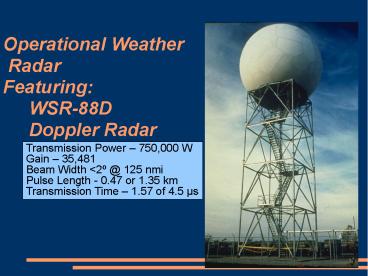Operational Weather Radar Featuring: WSR-88D Doppler Radar PowerPoint PPT Presentation
Title: Operational Weather Radar Featuring: WSR-88D Doppler Radar
1
Operational Weather Radar Featuring WSR-88D
Doppler Radar
Transmission Power 750,000 W Gain 35,481 Beam
Width lt2º _at_ 125 nmi Pulse Length - 0.47 or 1.35
km Transmission Time 1.57 of 4.5 µs
2
DOWs measure record high wind speeds of 301 /-
20 mph (135 /- 10 m/s) in 03 May 1999 Oklahoma
City tornado.
3
Abstract
- Sensors
- WSR88 standard weather service radar
- 158 Operational Sites Across the Country
- Common Radar Bands K,Ku, C,X, Ka
- ?1-10cm, 1-10x size of particles (rain ice) of
interest - Makes use of Rayleigh Scattering
- Phased Array Radar
- Algorithms
- Radar Equation
- Attenuation
4
Brief Weather Radar History
- 1950 RADAR discovered
- RADAR RAdio Detection And Ranging
- In early use, WWII military operators picked up
on what they thought was noise - Really environmental returns, only noise if you
want to see airplanes - 1950-1980 Continued development of reflectivity
radar - 1980-2000 Invention and implementation of
Doppler radar - As of 1988 the US started using 10 cm wavelength
radars (WSR-88D) as their standard radar device
for radar networks - 2000-present Dual Polarization Radar and Phased
Array Radar
5
source http//www.cocorahs.org/media/docs/radar_b
asics.pdf
6
source http//www.cocorahs.org/media/docs/radar_b
asics.pdf
7
Introduction
- Key concepts
- Doppler effect
- Rayleigh scattering
- Sensing the return
- Reflectivity, dbz
- Vertical cross section
- Range Height Indication Scan
- Constant Azimuth
- Improvement with WSR-88D
- Volume Scanning
- Vary azimuth along with elevation
- Optimally interpolate 3d volume or reflectance
8
Radar, Doppler and Raleigh
- Radar Equation
- Whn transmiter and reciever are in the same
place, signal decreases in power to the fourth
power - Doppler Equation
- Where F observed frequency, F emitted
frequency, v velocity in medium, vs velocity
of source - Raleigh Scattering
- EM radiation returned from a field with average
particle size smaller than the wavelength of the
radiation
9
Reflectivity off a target
- Power of the return signal - reflectivity (z)?
- z has the units mm6/m3 -
- density of water droplets which would return the
reflectivity - emissivity is implicit
- To cover a large range it is often described in
decibels - Intensity of the return echo helps determine the
precipitation rate - significant precipitation
usually is above 15 dBz - Reported reflectivity is an average of
at least 25 pulses from a given azimuth
and elevation
10
Applications
- Nowcast/ short term forecast
- useful for extreme weather
- Easily deployed in remote locations
- Lee Rotors
- Precipitation Estimation
- Links to related topics
- RUCOOL Codar Maps
- Radar Altimetry
- Police Radar
- Small Aircraft Detection
- Benefits from radial
movement of parts
11
Radar Bands and Uses
- 2-4 S GHz, 7.5-15cm. Sirius and XM radio. Long
range weather, marine weather, ATC - 4-8 Ghz - C band satellite transponders,
satellite TV, raw satellite communications,
weather. - 18-27 Ghz - K - police, small drizzle/fog
research ? - 27-40 Ghz Ka police
- 8-12 Ghz - X airport radar very long range,
missile guidance
12
Making a Signal
- The listen time (millisecond) is 1000x the
pulse duration - This allows the radar an opportunity to be able
to receive the signal again without interference
from previous signals - Must wait until signal has reached maximum range
and returned. - Knowing exact pulse travel time allows for
calculation of the horizontal distance to the
target - Intensity of the return, or backscatter -gt target
size - Radial Target Motion -gt Doppler shift
13
What happens to the returned signal?
- Must orient the returns (power at certain
frequencies) into an accurate measure of
precipitation - Measurements over a spherical volume are sliced
up into horizontally and vertically to produce
2,3 and 4d visualizations - Account for ambient background noise
14
Source http//cimms.ou.edu/rvamb/Documents/Report
_7.pdf
15
Algorithms
- VIL
- Vertically Integrated Liquid
- HAIL
- Estimates presence and size of
hailstones - Potential Wind Gusts
- Uses VIL, cloud top height
- Estimates the winds under the cloud (ie
downdraft)? - Doppler measurement readily reveals wind shear
storm relative velocity - Mesocyclone Detection Algorithm
- Tornado Detection Algorithm
- Wind Shear Detection (low level)?
16
Products
- Base reflectivity
- how much precipitation is falling
- precipitation type
- assess a storm's structure and dimension
- Composite Reflectivity
- Scans from all elevations, imaging precipitation
intensity and storm structure - Base Velocity
- radial wind field, speed of fronts/strong wind
- range of 140 mi
- Storm relative motion
- Track a circulation (show up well in doppler
return) over time to determine storm motion. - Removing the storm relative motion from base
radials gives an estimate of the flow with
respect to the storm.
17
Complications
- Migrating Birds
- Insects
- Aircraft, solid buildings,
- large aerosols
- for air traffic controller rain
- for meteorologist airplanes.
- Identification of snow, and snow type,
- modification of observed matter before hitting
the ground (fallstreaks)? - big enough sample of precip for identification?
- In precip estimates Z-R relationship
18
Phased Array Radar
Proven NAVY technology
- Multiple beams with variable dwell times scan
continuously - perform full volume scan every 20-30s
- track cooperative aircraft
- track non-cooperative aircraft
- perform medium dwell scan on heavy cumuliform
convection - perform long dwell scan on area of suspected
tornadic development. - Expected that tornado warning could in to to 45
min
19
In Closing
- Take precipitation rates with caution
- Highly accurate under most conditions
- Misleading in cases of extreme precipitation
- The ultimate in nowcast and high resolution
spatial time series for precipitation. - Extremely useful in adaptive forecasting of
extreme weather events

